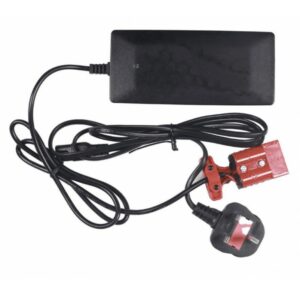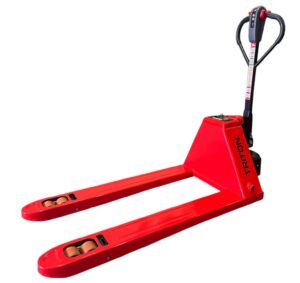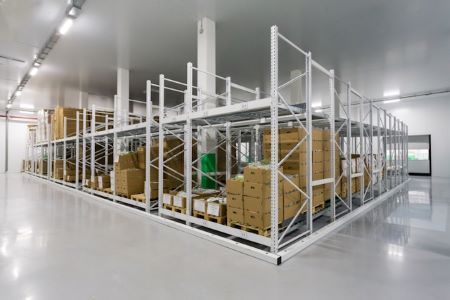Although pallet trucks are undeniably one of the most important pieces of equipment in the warehouse, they can also be the cause of a range of hazards if not used correctly.
As a warehouse manager, it’s important to be aware of these hazards and be proactive in mitigating them. Keep on reading to find out more about these top hazard:
1. Overloading
Pallet trucks have a designated weight capacity, exceeding which creates a recipe for disaster.
Overloaded pallet trucks are unstable and can lead to:
- Tip-overs: The forks holding the load can topple forward, the operator can lose control, and fall or be crushed by the pallet and cargo.
- Component failure: If the truck’s wheels, forks or hydraulics are put under too much stress by an overload, it can cause them to fail, with the potential for falling parts to injure people as well.
Solutions:
- Know the weight limit: Clearly identify the weight capacity of each pallet truck and ensure it’s easily visible to operators.
- Invest in the right equipment: For heavier loads, consider powered pallet trucks with a higher weight capacity.
- Encourage weighing: If unsure about load weight, encourage operators to use weighing scales to ensure safe handling.
2. Uneven surfaces
Warehouse floors are not always pristine. Uneven surfaces like cracks, potholes, or bumps can create a safety hazard when using pallet trucks.
These uneven surfaces could cause a pallet truck operator to lose control of the machinery, causing injury to the operator, or could cause damage to the truck.
Solutions:
- Keep the floor in good condition: Inspect and repair the warehouse floor on a regular basis, paying attention to cracks, bumps, or other problems with its surface.
- Put up warnings: Mark with clear signs uneven surfaces to alert operators and make them slow down.
- Reduce speed: Encourage operators to slow down and travel cautiously when navigating uneven terrain.
3. Pinch points
Pallet trucks have several pinch points where hands or fingers can get crushed during operation.
Common pinch points are between the forks and the pallet, within the scissors mechanism that raises and lowers the forks, and around the wheels and frame of the truck.
Solutions:
- Keep safe operating distances: Train operators to keep hands clear of all pinch points whilst using the pallet truck.
- Wear proper gloves: Ask employees to wear well-fitting, pinch- and scrape-resistant gloves.
- Check the truck regularly: Look for signs of wear and tear in the hydraulic systems and rollers that could lead to pinches.
4. Collisions
The fast pace of warehouse operations can lead to collisions between pallet trucks and other moving objects.
Not only could collisions in the warehouse lead to injury, but it could also cause damage to property like the pallets, inventory, or other warehouse equipment if you’re not careful.
Solutions:
- Promote traffic awareness: Make sure there is a clear traffic circulation plan for pedestrians, pallet trucks and other vehicles in the warehouse.
- Set limits of speed: Ensure that the speed limits are set appropriately and enforced on the pallet trucks so as to avoid collision.
- Use warning signals and signs: Have auditory warning devices such as a horn or flashing lights on your pallet truck, or post warning signs at intersections and blind corners reminding the operator to yield or stop.
5. Improper lifting techniques
Pallet trucks eliminate the need for manual lifting of heavy loads; however, improper techniques when using the truck can still lead to back injuries.
Lifting with a bent back or twisting the body while maneuvering a loaded pallet truck can strain muscles and cause long-term back problems.
Solutions:
- Ergonomics are important: Select pallet trucks with ergonomic features such as adjustable tillers and padded handles, which encourage the operator to adopt a good posture and minimise back and shoulder stress.
- Train on correct practices: Give complete training to operators on correct practices for lifting when operating a pallet truck, such as keeping the back straight, using legs to lift and lower the load, etc.
- Use lifting aids: If lifting is a frequent task, using lifting aids such as stackers, lift tables, etc reduces the need for manual effort by workers.
Safety in the warehouse
Adopting these solutions and encouraging healthy working practices could greatly decrease the number of accidents caused by pallet trucks in the warehouses. A safe and healthy workforce is a productive workforce, which means a more effective warehousing operation.
After all, safety is a way of life, not a one-off training session. The more that warehouses invest in the process of continuous safety training, tools and communication, the more that their workplaces will become safe spaces where staff feel empowered, able and willing to do their best work.
























